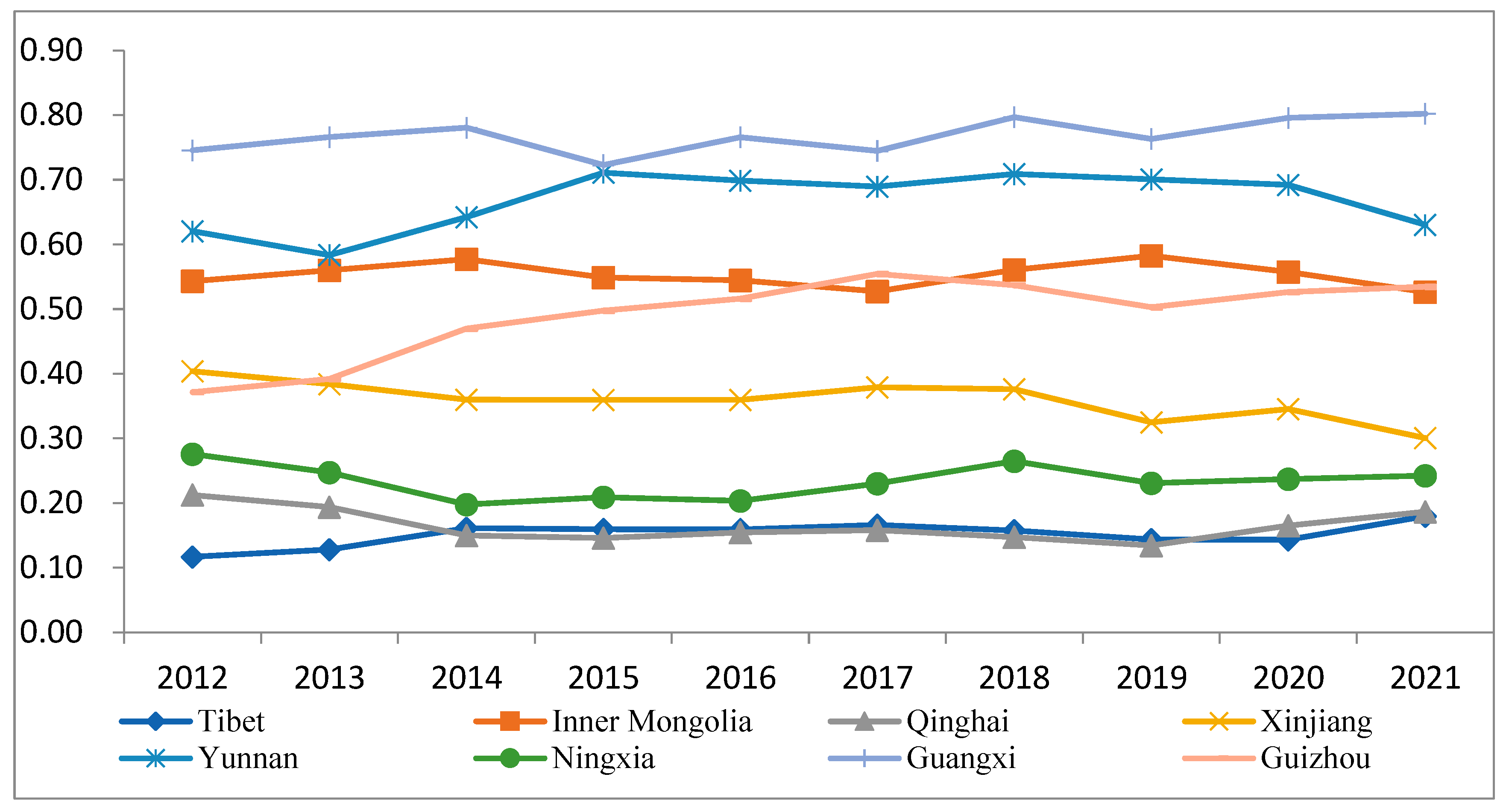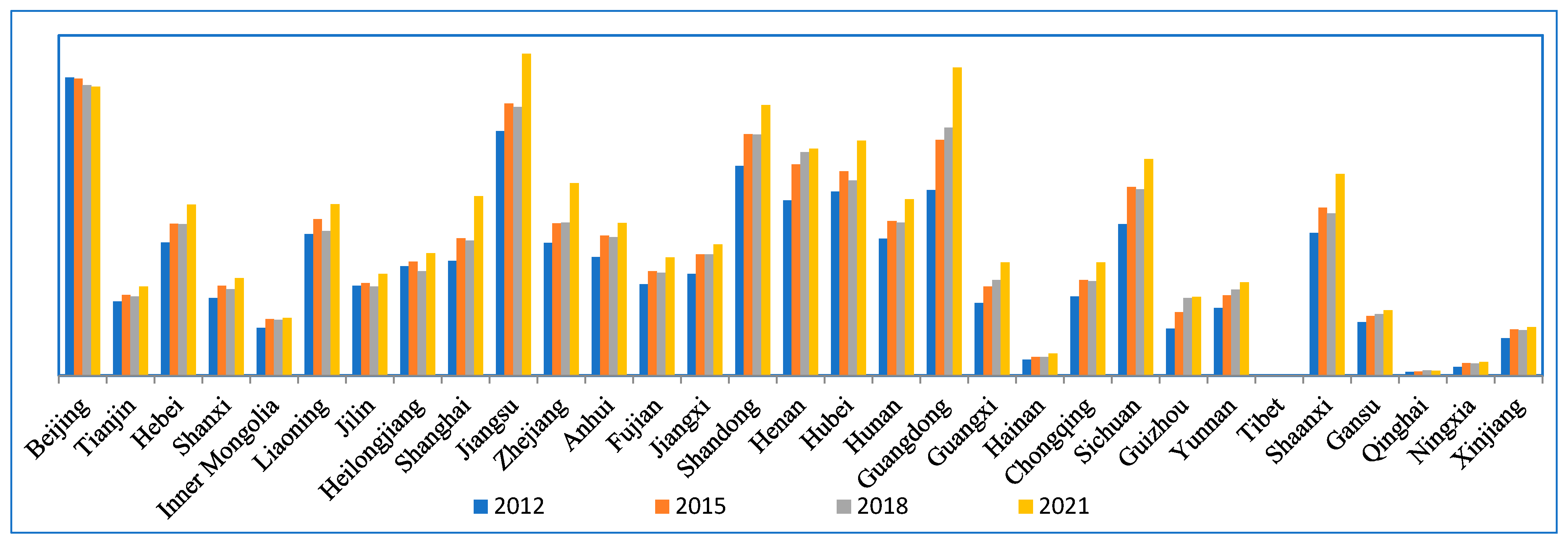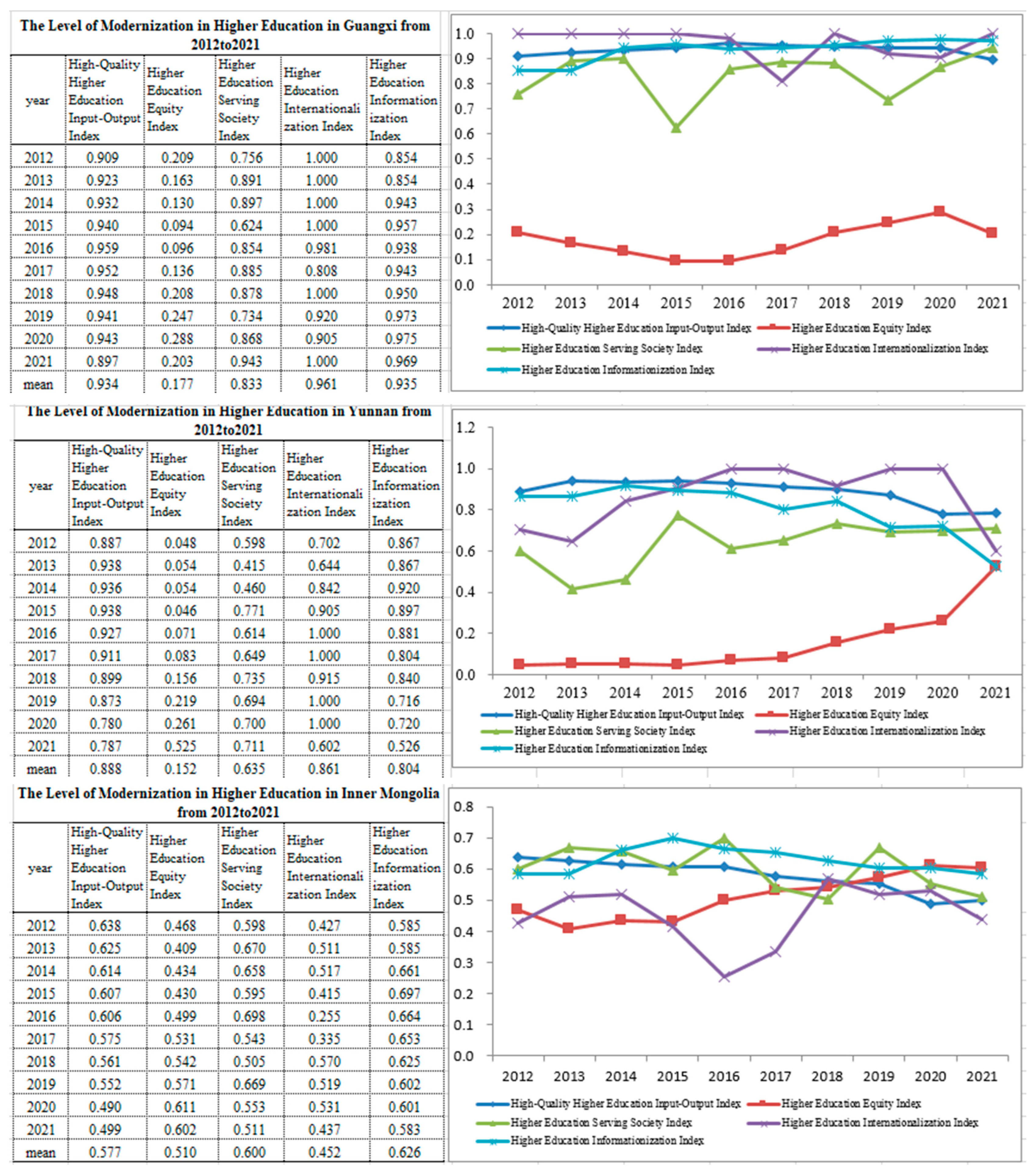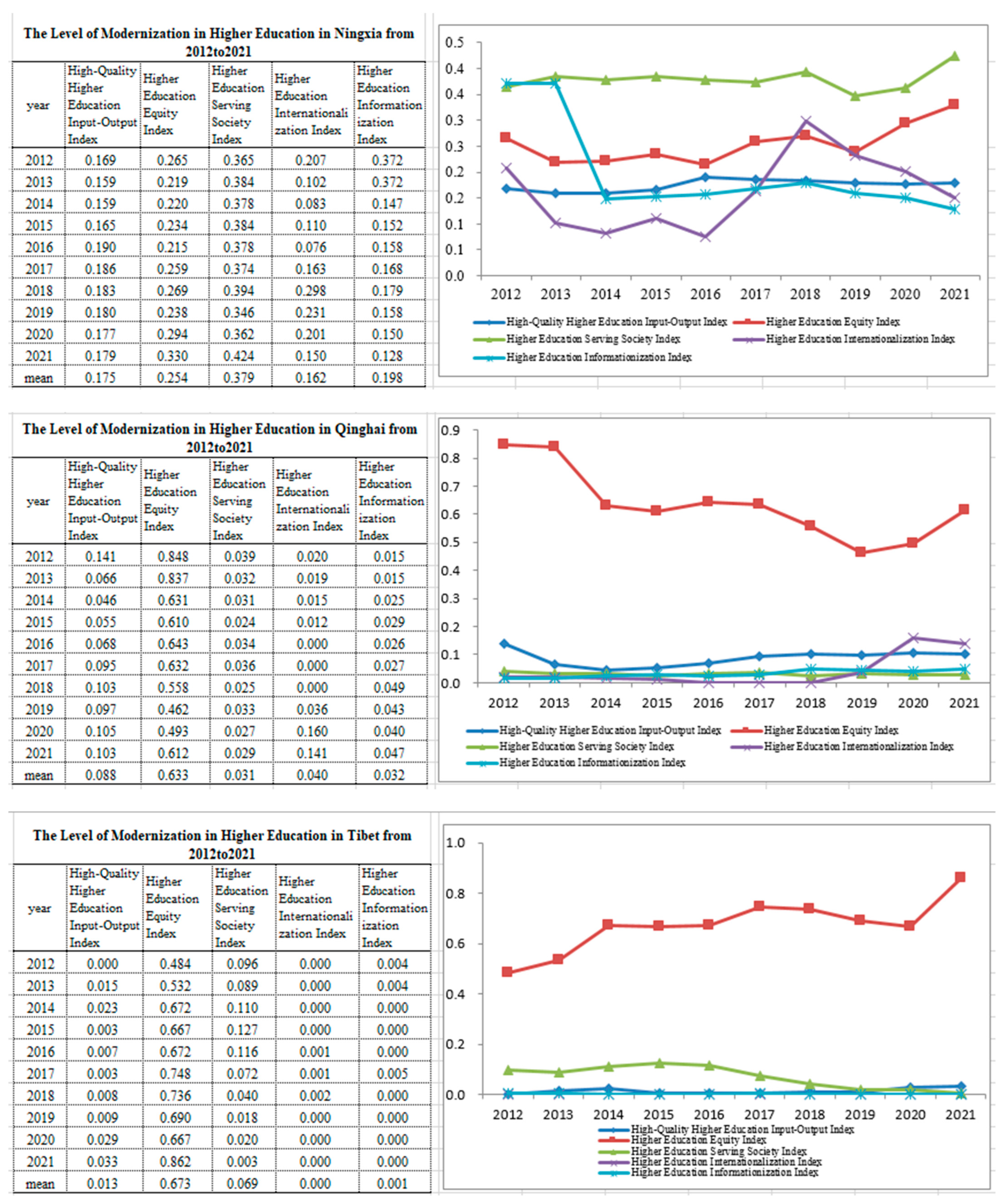Assessing the Modernization of Higher Education in China’s Eight Ethnic Minority Provinces: A Decade-Long Panel Data Analysis (2012–2021)
Abstract
1. Introduction
2. Theoretical Review
2.1. Concept of Educational Modernization
- Educational Modernization as the Enhancement of Educational Modernity: Yuan, L. P. [4] posits that “the essence of educational modernization is the augmentation of educational modernity.” The Chinese Society of Educational Development Strategy further elucidates that educational modernization is the dynamic process by which education incrementally aligns with the imperatives of contemporary societal evolution, thereby catalyzing the progressive escalation of educational modernity.
- Educational Modernization as the Modernization of Educational Form: Li, X. S. [5] conceptualizes educational modernization as the transformative process targeting the modernization of the educational form. This perspective emphasizes the structural and operational changes within the educational system to meet modern standards and expectations.
- Educational Modernization as Human Modernization: Scholars such as Wu, Z. H. [6] and Wu, Y. [7] advocate that educational modernization is fundamentally the process of human modernization. They argue that this modernization entails the enhancement of human modernity and the cultivation of a modernized personality. This viewpoint highlights the role of education in fostering individual attributes and capabilities that are consonant with modern societal norms and values.
2.2. Content, Standards, Features, Theories, Conditions, Value Orientation, or Value Goals of Educational Modernization
2.3. The Third Aspect Is the Developmental History of Educational Modernization
2.4. The Fourth Aspect Concerns China’s Important Discourse on Educational Modernization
2.5. The Fifth Aspect Is the Construction of the Evaluation Index System for Modernization of Higher Education
2.6. The Sixth Aspect Pertains to the Comparative Study of the Evaluation Index System for the Modernization of Higher Education
2.7. The Seventh Aspect Is the Constituent Elements of Higher Education Modernization
- Education Equity and Accessibility: Guaranteeing that high-quality education is attainable for all individuals, irrespective of their background or geographical location.
- Talent Cultivation and Innovation: Nurturing the development of elite talent and fostering innovation capabilities to meet the demands of a knowledge-driven society.
- Information Technology Integration: Embracing and effectively utilizing advancements in information technology to revolutionize and enhance educational methodologies and practices.
- Globalization and Openness: Expanding international collaborations and exchanges to bolster the openness and global competitiveness of higher education institutions.
- Lifelong Learning and Personalized Education: Instituting a lifelong learning framework that accommodates diverse needs and preferences, thereby promoting personalized educational pathways for continuous growth and development.
3. Construction of Evaluation Index System
4. Research Results
4.1. Overall Level of Higher Education Development in Eight Ethnic Provinces Shows a Rising Trend
4.2. The Level of Higher Education Development in the Eight Ethnic Provinces and Regions Fluctuates, with Tibet Showing the Greatest Increase and Xinjiang Experiencing the Largest Decline
4.3. There Is a Significant Difference Between the Modernization Development Level of Higher Education in Ethnic Minority Regions and the National Average Level
4.4. Subdivision and Ranking of Higher Education Development Indices in the Eight Provinces in Ethnic Minority Areas
- Guangxi (2012–2021):
- 2.
- Yunnan Province (2012–2021):
- 3.
- Inner Mongolia (2012–2021):
4.5. Correlation Analysis Between the Modernization Level of Higher Education in Ethnic Minority Regions and Economic Development
5. Trend Forecasting Based on the Grey GM(1,1) Prediction Model
5.1. Theoretical Background
5.2. Relevance to Our Study
5.3. Grey GM(1,1) Prediction Model
6. Conclusions
- Internationalization of Higher Education:Significant improvements are needed in Tibet (0), Qinghai (0.04), Ningxia (0.162), Xinjiang (0.322), Guizhou (0.348), and Inner Mongolia (0.452). These regions exhibit relatively low levels of international engagement, which is critical for enhancing global competitiveness and academic exchange.
- 2.
- Equity in Higher Education:Key regions requiring attention include Yunnan (0.152), Guizhou (0.156), Guangxi (0.177), Xinjiang (0.201), and Inner Mongolia (0.51). Addressing disparities in access and quality is essential to ensure equitable educational opportunities across these provinces.
- 3.
- Informatization of Higher Education:Tibet (0.001), Qinghai (0.032), and Ningxia (0.198) have been identified as regions with the most pressing need for improvement in digital infrastructure and technology integration. Enhancing informatization is crucial for modernizing educational delivery and expanding access to digital resources.
- 4.
- High-Quality “Input–Output” Efficiency in Higher Education:Tibet (0.013) and Ningxia (0.175) require targeted interventions to optimize resource allocation and improve the efficiency of educational investments. Strengthening the alignment between inputs and outputs is vital for achieving sustainable development.
- 5.
- Social Service Capacity in Higher Education:Qinghai (0.031) and Xinjiang (0.298) need to enhance their higher education institutions’ ability to contribute to societal development. This includes fostering partnerships with local industries and communities to address regional challenges and promote economic growth.
Author Contributions
Funding
Institutional Review Board Statement
Informed Consent Statement
Data Availability Statement
Acknowledgments
Conflicts of Interest
References
- Bhutto, A.; Rashdi, P.I.; Abro, Q.M. Indicators for science and technology policy in Pakistan: Entering the science, technology and innovation paradigm. Sci. Public Policy 2012, 39, 1–12. [Google Scholar] [CrossRef]
- Cai, W.; Cao, Y.; Zhao, Z. Measurement and Evaluation of the Modernization Level of Education Development in Ethnic Areas: An Analysis Based on the Education Development Index from 2011 to 2019. Qinghai J. Ethnol. 2022, 33, 186–193. [Google Scholar]
- Dagum, C. A new approach to the decomposition of the Gini income inequality ratio. Empir. Econ. 1977, 22, 515–531. [Google Scholar] [CrossRef]
- Yuan, L.P. The modernity dimensions of educational modernization and their transcendence. J. Shaanxi Norm. Univ. 2020, 49, 159–168. [Google Scholar]
- Li, X.S. How should educational modernization “modernize”? Educ. Dev. Res. 2020, 40, 9–15. [Google Scholar]
- Wu, Z.H.; Zhang, P. The logical purpose of localized educational leadership of rural school principals. Educ. Res. 2020, 41, 126–134. [Google Scholar]
- Wu, Y. Chinese-style modernization and innovative development of higher education reform. China High. Educ. Res. 2022, 11, 21–29. [Google Scholar]
- Liu, Z.H.; Hu, Z.P. A review and reflection on the process of Western educational modernization. Comp. Educ. Res. 1998, 9, 8–12. [Google Scholar]
- Chu, H.Q. Reflections on constructing the index system of educational modernization. China High. Educ. 2013, 6, 14–16+26. [Google Scholar]
- Pan, X.W. The Chinese logic of educational modernization. Educ. Sci. Mon. 2022, 11, 3–10+77. [Google Scholar]
- Zhang, Y.T. Educational modernization in China since the founding of the People’s Republic: Evolution, characteristics, and paths. Heilongjiang Educ. 2020, 11, 30–32. [Google Scholar]
- Liu, Y. Research on the ten frontier issues of Xi Jinping Thought on Socialism with Chinese Characteristics for a New Era (2023). Marx. Res. 2024, 1, 143–159. [Google Scholar]
- Huang, J.J. On the Internal Logic of the Theoretical System of Chinese-Style Modernization. Marxist Studies. 2024. Available online: http://kns.cnki.net/kcms/detail/11.3591.A.20240606.1418.028.html (accessed on 29 June 2024).
- Chang, S. Difficulties and Countermeasures in the Reform of Educational Evaluation. Shanghai Educ. Res. 2022, 12, 1. [Google Scholar]
- Cheng, T.; Zhang, M.; Qin, Y.; Sui, Y.; Zhou, H.; Zheng, S. Reflections and Directions on Deepening the Reform of Educational Evaluation in the New Era. China Electr. Educ. 2021, 7, 1–12+21. [Google Scholar] [CrossRef]
- Fang, F.; Zhong, B. Theoretical Logic and Practical Thinking on the High-Quality Development of Higher Education under the New Development Pattern of “Dual Circulation”. China High. Educ. Res. 2022, 38, 21–27. [Google Scholar]
- Huang, Y.; Zhou, H.; Huang, J. China’s Educational Competitiveness: Construction of Evaluation Index System and International Comparison. Stat. Decis. 2022, 38, 74–78. [Google Scholar]
- Jin, Y.; Piao, X.; Zhao, T.; Liu, X.; Si, L. Discussion: Reform and Institutional Innovation of Educational Evaluation in the New Era. Univ. Educ. Sci. 2021, 1, 13–25. [Google Scholar]
- Li, D.; Fang, L.; Su, R. Research on the Comprehensive Development Level and Balance Degree of Higher Education in China: An Analysis Based on the PLS Structural Equation Model. Mod. Educ. Manag. 2021, 4, 61–74. [Google Scholar]
- Li, L.; Wang, J.; Chen, L.; Wang, C. The New Era Significance and Collaborative Promotion Path of Chinese-style Higher Education Modernization. China Educ. Technol. 2023, 1, 81–91. [Google Scholar]
- Liu, Y. Research on the Evaluation and Promotion Path of Higher Education Modernization Development Level in Western Region. Ph.D. Thesis, Northwest University, Xi’an, China, 2022. [Google Scholar]
- Li, Z.; Cui, X. Sources of Growth of Human Capital and Its Contribution to China’s Economic Growth. Soft Sci. 2022, 36, 33–38. [Google Scholar]
- Liu, Z.; Zhao, Z. Sustainable Development: Implications and Paths for Building a High-Quality Higher Education System. High. Educ. Manage. Univ. 2023, 17, 12–23. [Google Scholar]
- Sui, Y.; Fu, Y. Self-reliance and Self-strengthening in Science and Technology: Systematic Reconsideration of the Construction and Effectiveness Evaluation of the “Double First-Class” Initiative. Res. High. Educ. China 2022, 12, 18–27. [Google Scholar]
- Wang, X.; Zhang, J. Theoretical Implications and Practical Pathways of High-Quality Development of Higher Education. High. Educ. Manag. 2023, 17, 21–31. [Google Scholar]
- Wu, S. Seeking New Breakthroughs to Consolidate Consensus for the Development of Education in Ethnic Areas: Hot Topics Concerned by Delegates and Members of the National People’s Congress in Central and Western China from the Perspective of the 2023 Two Sessions. China Natl. Educ. 2023, 4, 8–11. [Google Scholar]
- Zhong, B. The Foundation and Key Points of China’s Higher Education Development during the “14th Five-Year Plan” Period. J. Hebei Norm. Univ. 2021, 23, 1–8. [Google Scholar]
- Zhou, J. Analysis of the Path to High-Quality Development of Higher Education in Ethnic Areas: Taking the “Five News” as the Starting Point. J. Tibet Univ. 2023, 38, 253–260. [Google Scholar]
- The Ministry of Education Held the 2024 Ministerial and Provincial Joint Construction Work Conference. Available online: http://www.moe.gov.cn/jyb_zzjg/huodong/202404/t20240412_1125271.html (accessed on 12 April 2024).
- Butt, N.U.S.Z.; Wang, X.; Luo, L.; Ul Hussan, H. Evaluating the Impact of Urban Encroachment and Land Cover Changes on World Cultural Heritage Site Taxila: A Spatio-Temporal Analysis from 1990 to 2024. Sustainability 2025, 17, 1059. [Google Scholar] [CrossRef]
- UNESCO. State of Conservation Report. 1995. Available online: https://whc.unesco.org/en/soc/2027 (accessed on 19 September 2024).








| Primary Indicator | Secondary Indicator | Tertiary Indicator | Unit | Attribute |
|---|---|---|---|---|
| Index of High-Quality Input–Output (A1) | Input Indicator | Number of Schools | Unit | + |
| Number of Faculty and Staff | Persons | + | ||
| Number of Full-time Teachers | Persons | + | ||
| Ratio of Teachers with Doctoral Degrees in Full-time Teaching Staff | % | + | ||
| Number of Teachers with Senior Professional Titles in Full-time Teaching Staff | Persons | + | ||
| Expenditure on Education | CNY 10,000 | + | ||
| General Public Budget for Educational Expenses | CNY 1000 | + | ||
| Area of School Property Buildings | Square Meters | + | ||
| Number of Books | Volumes | + | ||
| Output Indicator | Undergraduate Enrollment | Persons | + | |
| Total Enrollment | Persons | + | ||
| Number of Undergraduate Graduates | Persons | + | ||
| Number of Graduate (Postgraduate) Graduates | Persons | + | ||
| Index of Higher Education Equity (A2) | Equal Opportunity | Gross Enrollment Ratio in Higher Education | % | + |
| Procedural Fairness | Student–Teacher Ratio | % | − | |
| Per Capita Education Expenditure per Student | CNY | + | ||
| Index of Higher Education in Serving Society (A3) | Talent Assurance | Average Number of University Students per 100,000 Population | Persons | + |
| Research Transformation | Income from Patent Ownership Transfer and Licensing | CNY 10,000 | + | |
| R&D Expenditure in Universities | CNY 10,000 | + | ||
| Number of R&D Projects in Universities | Item | + | ||
| Index of Higher Education Internationalization (A4) | Scientific Research | Number of Scientific Papers Published Abroad | Article | + |
| Index of Higher Education Informatization (A5) | Infrastructure | Number of Network Multimedia Classrooms | Unit | + |
| Number of Computers (Units)/Digital Terminals | Unit | + | ||
| Security System | Value of Information Technology Equipment Assets | CNY 10,000 | + |
| Index | 2012 | 2013 | 2014 | 2015 | 2016 | 2017 | 2018 | 2019 | 2020 | 2021 | Increment |
|---|---|---|---|---|---|---|---|---|---|---|---|
| Overall Index of Higher Education Modernization (B1) | 0.411 | 0.407 | 0.417 | 0.419 | 0.425 | 0.431 | 0.444 | 0.423 | 0.433 | 0.425 | 0.404 |
| Index of High-Quality Input–Output (A1) | 0.481 | 0.481 | 0.482 | 0.487 | 0.499 | 0.497 | 0.493 | 0.477 | 0.453 | 0.454 | −0.607 |
| Index of Higher Education Equity (A2) | 0.352 | 0.325 | 0.316 | 0.301 | 0.319 | 0.351 | 0.351 | 0.341 | 0.365 | 0.423 | 2.331 |
| Index of Higher Education Serving Society (A3) | 0.380 | 0.389 | 0.408 | 0.421 | 0.448 | 0.472 | 0.425 | 0.409 | 0.422 | 0.445 | 1.907 |
| Index of Higher Education Internationalization (A4) | 0.347 | 0.343 | 0.383 | 0.388 | 0.368 | 0.357 | 0.460 | 0.432 | 0.472 | 0.384 | 1.892 |
| Index of Higher Education Informatization (A5) | 0.497 | 0.497 | 0.497 | 0.499 | 0.490 | 0.480 | 0.490 | 0.454 | 0.451 | 0.421 | −1.784 |
| Year | Tibet | Inner Mongolia | Qinghai | Xinjiang | Yunnan | Ningxia | Guangxi | Guizhou | Average |
|---|---|---|---|---|---|---|---|---|---|
| 2012 | 0.117 | 0.543 | 0.212 | 0.404 | 0.620 | 0.276 | 0.745 | 0.372 | 0.411 |
| 2013 | 0.128 | 0.560 | 0.194 | 0.384 | 0.584 | 0.247 | 0.766 | 0.392 | 0.407 |
| 2014 | 0.161 | 0.577 | 0.150 | 0.360 | 0.642 | 0.198 | 0.780 | 0.470 | 0.417 |
| 2015 | 0.159 | 0.549 | 0.146 | 0.359 | 0.711 | 0.209 | 0.723 | 0.498 | 0.419 |
| 2016 | 0.159 | 0.544 | 0.154 | 0.359 | 0.699 | 0.203 | 0.766 | 0.516 | 0.425 |
| 2017 | 0.166 | 0.527 | 0.158 | 0.379 | 0.689 | 0.230 | 0.745 | 0.554 | 0.431 |
| 2018 | 0.157 | 0.561 | 0.147 | 0.376 | 0.709 | 0.265 | 0.797 | 0.537 | 0.444 |
| 2019 | 0.143 | 0.582 | 0.134 | 0.325 | 0.701 | 0.231 | 0.763 | 0.503 | 0.423 |
| 2020 | 0.143 | 0.557 | 0.165 | 0.345 | 0.692 | 0.237 | 0.796 | 0.526 | 0.433 |
| 2021 | 0.180 | 0.526 | 0.186 | 0.301 | 0.630 | 0.242 | 0.802 | 0.534 | 0.425 |
| Average | 0.151 | 0.553 | 0.165 | 0.359 | 0.668 | 0.234 | 0.768 | 0.490 | 0.423 |
| Increment | 5.533 | −0.260 | −0.627 | −2.991 | 0.367 | −0.784 | 0.925 | 4.341 | 0.813 |
| Year | Tibet | Inner Mongolia | Qinghai | Xinjiang | Yunnan | Ningxia | Guangxi | Guizhou |
|---|---|---|---|---|---|---|---|---|
| 2022 | 0.192 | 0.562 | 0.214 | 0.316 | 0.705 | 0.248 | 0.796 | 0.581 |
| 2023 | 0.210 | 0.560 | 0.240 | 0.331 | 0.712 | 0.254 | 0.801 | 0.598 |
| 2024 | 0.228 | 0.559 | 0.266 | 0.346 | 0.719 | 0.259 | 0.806 | 0.614 |
| 2025 | 0.246 | 0.557 | 0.292 | 0.361 | 0.726 | 0.265 | 0.811 | 0.631 |
| 2026 | 0.264 | 0.555 | 0.318 | 0.376 | 0.733 | 0.271 | 0.816 | 0.647 |
| 2027 | 0.282 | 0.603 | 0.344 | 0.391 | 0.739 | 0.276 | 0.821 | 0.664 |
| 2028 | 0.300 | 0.618 | 0.370 | 0.407 | 0.746 | 0.282 | 0.826 | 0.680 |
| 2029 | 0.318 | 0.641 | 0.397 | 0.422 | 0.753 | 0.288 | 0.831 | 0.697 |
| 2030 | 0.337 | 0.664 | 0.423 | 0.437 | 0.760 | 0.293 | 0.836 | 0.713 |
| 2031 | 0.355 | 0.687 | 0.449 | 0.452 | 0.767 | 0.299 | 0.841 | 0.730 |
| Province | Weaknesses | Key Advancement Paths | ||
|---|---|---|---|---|
| Tibet | A4 (0) | A5 (0.001) | A1 (0.013) | 1. In response to the low level of internationalization in higher education, amidst the drive for global economic integration and societal informatization, various approaches and methods should be employed to promote the internationalization of higher education. The focus should primarily be on the internationalization of educational resources and educational ideologies.; 2. In response to the relatively low level of informatization in higher education, given the widespread and deep application of modern information technology, initiatives should be accelerated to advance educational informatization. This entails leveraging informatization construction to promote innovation in education and teaching. Measures include establishing educational resource platforms, among others.; 3. To address the low level of equity in higher education, it is essential to highlight equality in educational opportunities, fairness in the educational process, and equity in educational outcomes.; 4. In response to the relatively low level of high-quality “input–output” indices in higher education, it is necessary to increase investment in higher education. This will facilitate the interaction between the modernization of Chinese higher education and the high-quality development of the economy. |
| Inner Mongolia | A4 (0.452) | A2(0.51) | ||
| Qinghai | A3 (0.031) | A5 (0.032) | A4 (0.04) | |
| Xinjiang | A2 (0.201) | A3 (0.298) | A4 (0.322) | |
| Yunnan | A2 (0.152) | |||
| Ningxia | A4 (0.162) | A1 (0.175) | A5 (0.198) | |
| Guangxi | A2 (0.177) | |||
| Guizhou | A2 (0.156) | A4 (0.348) | ||
Disclaimer/Publisher’s Note: The statements, opinions and data contained in all publications are solely those of the individual author(s) and contributor(s) and not of MDPI and/or the editor(s). MDPI and/or the editor(s) disclaim responsibility for any injury to people or property resulting from any ideas, methods, instructions or products referred to in the content. |
© 2025 by the authors. Licensee MDPI, Basel, Switzerland. This article is an open access article distributed under the terms and conditions of the Creative Commons Attribution (CC BY) license (https://creativecommons.org/licenses/by/4.0/).
Share and Cite
Liang, Q.; Li, K. Assessing the Modernization of Higher Education in China’s Eight Ethnic Minority Provinces: A Decade-Long Panel Data Analysis (2012–2021). Sustainability 2025, 17, 2567. https://doi.org/10.3390/su17062567
Liang Q, Li K. Assessing the Modernization of Higher Education in China’s Eight Ethnic Minority Provinces: A Decade-Long Panel Data Analysis (2012–2021). Sustainability. 2025; 17(6):2567. https://doi.org/10.3390/su17062567
Chicago/Turabian StyleLiang, Qingqing, and Kaiyi Li. 2025. "Assessing the Modernization of Higher Education in China’s Eight Ethnic Minority Provinces: A Decade-Long Panel Data Analysis (2012–2021)" Sustainability 17, no. 6: 2567. https://doi.org/10.3390/su17062567
APA StyleLiang, Q., & Li, K. (2025). Assessing the Modernization of Higher Education in China’s Eight Ethnic Minority Provinces: A Decade-Long Panel Data Analysis (2012–2021). Sustainability, 17(6), 2567. https://doi.org/10.3390/su17062567





